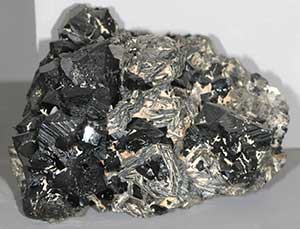 |
| Cassiterite - SnO2. |
Tin is a silvery-white metallic element. The most important ore mineral of tin, cassiterite (tin dioxide), is formed in high-temperature veins that are usually related to igneous rocks, such as granites and rhyolites; it is often found in association with tungsten minerals. Tin is mined in 22 countries; China, Indonesia, and Peru are the three major producers. Tin is used predominantly in a variety of such alloys as babbitt metal, brass/bronze, and solder; another important use is in tinplate for tin cans.
Background
Tin has been known from ancient times. Ancient peoples found that heating the tin mineral cassiterite (sometimes found in streams as nuggets) in a charcoal fire, they could produce the silvery, soft metal we know as tin.
Tin is a silvery-white metallic element with atomic number 50. Tin is malleable, meaning it is easily shaped by hammering. Pure tin also has a relatively low melting point, easily attainable in a wood fire, and is therefore easy to melt and cast in a clay mold. Tin is stable in air and water, meaning it does not oxidize or react easily . When pure tin is bent rapidly, it makes a peculiar squealing noise: this is called the "tin cry."
The ancients found tin to be too soft to be of much use for other than decorative objects, and the use of pure tin in ancient times was restricted to mirrors, clasps, and decorative items. Some coins have been minted of tin, but the coins wear and bend rapidly. However, when mixed (alloyed) with copper, another metal which could be found in a nearly pure state in nature, then a new and much harder alloy resulted: bronze. This discovery marked the beginning of the historical period known as The Bronze Age. The advent of the Bronze Age, with the use of bronze spears, arrowheads, knives, sickles, and scythes, greatly enhanced the efficiency of hunters and farmers.
The most important ore mineral of tin, cassiterite (tin dioxide, SnO2) forms in high-temperature veins, usually related to igneous rocks such as granites and rhyolites. It is often found in association with tungsten minerals. When rocks containing cassiterite are weathered (decomposed by the action of surficial waters and oxidation), the cassiterite tends to remain intact, and eventually is concentrated in streams to form "placer" deposits, in a manner similar to gold nuggets in "placer" deposits. Ancient peoples recovered cassiterite from streams by panning, and even today panning or - more importantly - large-scale mechanical dredging of stream deposits and decomposed rock are a major means of producing cassiterite. Veins with a high enough cassiterite content to mine underground occur in China, Bolivia, Peru, and a few other countries.
Name
The name tin is an ancient Anglo-Saxon word. Tin in the form of cassiterite was mined in ancient Britain and was a major trade item between Britain and the Greeks and Phoenicians of the Mediterranean region. The chemical symbol for tin, Sn, comes from the Latin word for tin, stannum. Tin was one of only seven chemical elements known in pure form, and named by ancient peoples. The mineral cassiterite is named for the ancient Greek word for tin.
Sources
As noted earlier, the primary mineral source for tin is cassiterite. The most tin resources in the United States are in Alaska, but these are relatively insignificant, and the U.S. has long imported its tin from other countries.
World resources to meet the demand for tin are sufficient for many decades to come. The primary producers of tin are China, Indonesia, and Peru, with lesser amounts from Brazil, Bolivia, Australia, and about a dozen other countries.
Uses
Much tin is used to coat so-called "tin" cans. Since tin does not oxidize (rust) in air or water, it is applied to the surface of flat-rolled steel to make tin plate, which is then fabricated to produce "tin" cans. This use accounts for about one-fourth of the tin consumed annually. Alloys such as bronze and pewter are also a major use of tin. Tin is useful in electrical applications, mainly low-melting-point solders, that account for one-fourth of tin consumption. It is also used in construction, transportation (mainly in bearings requiring soft metal alloys) and other various industrial applications. For example, window glass is made by pouring molten glass onto molten tin; this process results in flat sheets of glass. An alloy of tin and niobium has proven to be a "superconducting" compound at very low temperatures.
Substitutes and Alternative Sources
A number of materials can replace tin in its various applications. In the food packaging industry, plastics, paper, aluminum and glass can be used in place of metal "tin cans." Tin can be used as a non-toxic substitute for lead in solders, pewter, and shotgun pellets. On balance, the world production and consumption of tin have not grown during the past 20 years, due mainly to the substitution of tin by plastic in the manufacture of cans and other containers, such as tubes for toothpaste and ointments.